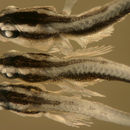en
names in breadcrumbs


Diagnosis: Fused pelvic fins and modal fin-ray counts of D-VII,12 A-11 and Pect-16-17 indicate some of the cleaner gobies of the genus Elacatinus (formerly considered Gobiosoma). The common shallow-water cleaner goby in Puerto Rico and the Lesser Antilles is E. evelynae, a V-nosed species.
Description: Larvae of the cleaner gobies are likely identical (described above under E. illecebrosus). Transitional recruits develop two wide dark stripes along the top of the head (separated by only a thin clear line) that merge to become a stripe along the base of the dorsal fin fading out between the two dorsal fins. Below the dark stripe is a prominent white stripe (yellow/blue in life) that meets the stripe from the other side in a distinct V-shape on the snout. A wide lateral dark stripe starts at the tip of the upper jaw and continues through the eye along the side of the body just below the lateral midline to the caudal fin, widening at the caudal-fin base and then extending out along the central and lower fin rays. Beneath this surface stripe is a broad dark stripe of internal melanophores that extends above and below the lateral midline.
Analogues: Larvae of the cleaner gobies are likely identical (analogues discussed above under E. illecebrosus), but recruits and juveniles of E. evelynae are separated from the other V-nosed species (E. genie and E. prochilos, both also "sharknosed") by a broad frenum connecting the snout to the upper lip. E. genie, a very similar species from the Bahamas and the Cayman Islands that shares the sharknose appearance is distinguished by having the upper lip separated from the snout by a deep groove. E. prochilos has the upper-lip groove, a more Y-shaped mark on the snout, and is not supposed to have the thin pale dorsal midline stripe from the dorsal fin forward (but whether this applies to new recruits is uncertain). The morphological differences of the mouth and snout may not be useful in the earliest recruit stages.
Elacatinus evelynae, the sharknose goby, Caribbean cleaner goby, Caribbean cleaning goby, is a species of goby native to the Western Atlantic Ocean from the Bahamas and the Lesser Antilles to the northern coast of South America, as well as the Antilles and western Caribbean.[2]
Elacatinus evelynae is a very small, torpedo-shaped fish. It can reach a maximum length of 4 cm (1.6 in). It has a yellow stripe in front of each eye that joins to form a V near the tip of its snout. Black stripes run under the yellow ones from the snout, over the lower part of the eye to the end of the caudal fin.[2] E. evelynae's fin configuration is the same as all other gobies. Its dorsal fin is split in two, with a rounded anterior fin and a flat posterior fin which lines up with its anal fin. The pectoral fins are almost circular. All its fins are transparent.
They inhabit coral reefs in clear ocean waters at a depth of 1–53 m (3 ft 3 in – 173 ft 11 in). The reported temperature range where they are found is 22 to 27 °C (72 to 81 °F).[2]
E. evelynae is a cleaner fish as indicated by one of its common names, the Caribbean cleaning goby. They feed on ectoparasites and dead skin[3] found on other fish.[2] E. evelynae also feeds on sponges, sea squirts, coral polyps, zooplankton and free-living copepods.[3] Females tend to clean and feed more than males especially if they are accompanied by a large male, which may be due to mate guarding and the male spending more time guarding the eggs.[4]
They are monogamous and are usually found in pairs near coral heads. Both males and females show aggression towards potential intruders of the same sex to protect their mates.[5] Attempts to breed them in captivity have shown that they do not produce eggs unless conditions are optimal, with little to no fluctuation in temperature and salinity.[6]
The specific name honours Evelyn McCutcheon (1894-1977), of Salt Cay in the Bahamas, who provided hospitality to James Erwin Böhlke and his fellow ichthyologist Charles C. G. Chaplin.[7]
Elacatinus evelynae, the sharknose goby, Caribbean cleaner goby, Caribbean cleaning goby, is a species of goby native to the Western Atlantic Ocean from the Bahamas and the Lesser Antilles to the northern coast of South America, as well as the Antilles and western Caribbean.